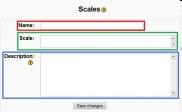Creating custom scales
Scales are a way of evaluating or rating a students’ performance. Moodle offers a standard set of numeric scales. It is also possible to create custom scales which can be available on the site. For example, you can give the student a word or small phrase as a way of rating or giving a student feedback.
Scales may be used in Forums, Glossaries and Assignments for rating and/or grading a student’s activity.
Moodle includes 100 different numeric scales which can not be edited, and one non-numeric example.
Numeric
Moodle includes numeric scales that range from a maximum of 100 to a minimum of 1. For example, selecting a scale of 10, will allow a rating on a scale between 10 and 1. Numeric scales can be calculated as a grade.
Included non numeric scales
Included in the standard 1.9 Moodle install is a scale called “Separate and Connected ways of knowing”. This has 3 elements: “Mostly Separate Knowing”, “Separate and Connected”, “Mostly Connected Knowing”. These phrases relate to a theory about how people approach the world. In edit mode, the teacher or administrator can see the scale description which explains the use of this interesting rating system.
Creating a new scale
New scales can be created by teachers with editing rights or by administrators or by any user with the manage scales role capability (Moodle 1.7 onwards). Since 1.9 the scales can be edited in the Gradebook Menu Scales. The process is similar for making a new scale for either a course or site.
Creating course scales
- Click on the Grades link in the course Administration block, then select Scales from the Edit section of the gradebook dropdown menu. (For versions of Moodle prior to 1.9, simply click on the Scales link in the course Course administration block.)
- On the Scales page click the “Add a new scale” button.
- On the next page give your scale a name in the Name box (highlighted in red in the screenshot) that will identify it among other scales.

- In the Scale box (highlighted in green), create your scale. Each item in the scale should be separated by a comma. You can use as many options here as you require. You must order the comma separated elements in increasing order of value. For example, an A,B,C,D scale must be entered as D,C,B,A.
- Write a detailed description in the Description box (highlighted in blue) for your scale. Your students will have access to the description, and you can use this to give them additional feedback. The more details you put in the description, the more students will understand what each scale item means.
Creating a site scale
Creating scales that are available in every course is similar to creating one for a single course. The site administrator will find a Scales link in the site administration block under Grades. It will list the scales available on the site, except the standard numeric sales.
In older versions of Moodle, Administrators has to create a site-wide scales by “promoting” a scale created for a course. To achieve this, add a new scale in any course, then use the move down arrow to move the scale from custom scales to standard scales (i.e. site-wide).
Using a scale
First the teacher needs to assign a specific scale to the activity using a drop down menu in the activities setting. Then the teacher and/or students can rate an activity element (for example, a post in a forum) with the pre-defined scale.
Editing a scale
If a scale has not yet been used, you will see an edit, move, and delete icon in the edit column.![]()
Once a scale is used for an activity, it is no longer possible to move or delete it, and you can only edit the scale name and description.
Values calculated as percentage scores
Moodle uses the last entry to determine the number of points in the scale for computing percentages. For example, if your scale is 0,5,6,7,8,9,10 then Moodle will use a 10 point scale and use 0/10, 5/10, … 9/10, 10/10 for grade computation, respectively.
TIP: If your scale is a custom non-value (not a number), Moodle’s behavior in combining or averaging the scores into a percentage value is unpredictable. When an average or aggregate is important, then it is a good idea to stick with the standard 100% scale to compute an overall grade.